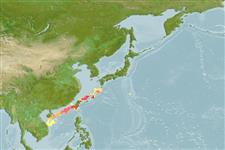Classification / Names
Nomi Comuni | Sinonimi | Catalog of Fishes (gen., sp.) | ITIS | CoL | WoRMS | Cloffa
Actinopterigi (pesci con pinne raggiate) >
Pleuronectiformes (Flatfishes) >
Cynoglossidae (Tonguefishes) > Symphurinae
Etymology: Symphurus: Greek, syn, symphysis = grown together + Greek, oura = tail (Ref. 45335); megasomus: Name derived from the Greek, 'mega' for large, and 'somus' for body, referring to the large size of this species and the deep body without obvious tapering in the posterior body.
Ambiente / Clima / Range
Ecologia
; marino benthopelagico; distribuzione batimetrica 200 - 640 m (Ref. 82423). Subtropical, preferred ?
Distribuzione
Stati | Aree FAO | Ecosystems | Presenze | Point map | Introduzioni | Faunafri
Northwest Pacific: Taiwan.
Length at first maturity / Size / Peso / Age
Maturity: Lm ?, range 10 - 14.342 cm
Max length : 14.7 cm SL maschio/sesso non determinato; (Ref. 82423); 14.3 cm SL (female)
Short description
Morfologia | Morfometria
Raggi dorsali molli (totale): 106-111; Raggi anali molli: 91 - 96; Vertebre: 55 - 58. This species is distinguished from all its congeners, except S. hondoensis and S. undatus, by its predominant 1-2-3-2-2 ID pattern. It also differs from both abovementioned species in having smaller eye (5.3-7.9% HL vs. 11.0-14.9% HL in S. hondoensis and 11.5-13.8% HL in S. undatus). This species further differs from S. hondoensis
in having 9 abdominal vertebrae (vs. 10). S. megasomus is also distinguished from S. undatus, by having higher fin-ray counts, 106-111 dorsal-fin rays and 91-96 anal-fin rays (vs. 101-105 dorsal-fin rays and 87-91 anal-fin rays) and a uniform straw-colored to dark brown ocular-side coloration (vs. freckled ocular-side pigmentation) (Ref. 82423).
This deep-water tonguefish species is known only from the continental shelf and upper continental slope off northeastern and eastern Taiwan; from 471-640 m by research vessels. Polychaetes, small crustaceans and some unidentified detritus were found in the digestive systems of fishes examined. Little else is known regarding the biology of this species (Ref. 82423).
Life cycle and mating behavior
Maturità | Riproduzione | Deposizione | Uova | Fecundity | Larve
Lee, M.-Y., H.-M. Chen and K.-T. Shao, 2009. A new species of deep-water tonguefish genus Symphurus (Pleuronectiformes: Cynoglossidae) from Taiwan. Copeia 2009(2):342-347. (Ref. 82423)
IUCN Red List Status (Ref. 115185)
CITES (Ref. 94142)
Not Evaluated
Threat to humans
Harmless
Human uses
Informazioni ulteriori
StatiAree FAOEcosystemsPresenzeIntroduzioniStocksEcologiaDietaPredeConsumo di ciboRazione
Age/SizeAccrescimentoLength-weightLength-lengthLength-frequenciesMorfometriaMorfologiaLarveDinamica popolazioni larvaliReclutamentoAbbondanza
BibliografiaAcquacolturaProfilo di acquacolturaVarietàGeneticaFrequenze allelicheEreditarietàMalattieElaborazioneMass conversion
CollaboratoriImmaginiStamps, CoinsSuoniCiguateraVelocitàModalità di nuotoArea branchialeOtolithsCervelliVista
Strumenti
Special reports
Download XML
Fonti Internet
